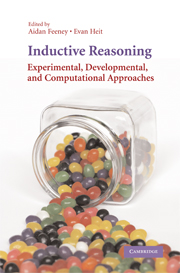Book contents
- Frontmatter
- Contents
- List of Figures
- List of Tables
- List of Contributors
- Preface
- 1 What Is Induction and Why Study It?
- 2 The Development of Inductive Reasoning
- 3 Interpreting Asymmetries of Projection in Children's Inductive Reasoning
- 4 Property Generalization as Causal Reasoning
- 5 Availability in Category-Based Induction
- 6 From Similarity to Chance
- 7 Theory-Based Bayesian Models of Inductive Reasoning
- 8 Use of Single or Multiple Categories in Category-Based Induction
- 9 Abductive Inference: From Philosophical Analysis to Neural Mechanisms
- 10 Mathematical Induction and Induction in Mathematics
- 11 Induction, Deduction, and Argument Strength in Human Reasoning and Argumentation
- 12 Individual Differences, Dual Processes, and Induction
- 13 Taxonomizing Induction
- Index
6 - From Similarity to Chance
Published online by Cambridge University Press: 26 February 2010
- Frontmatter
- Contents
- List of Figures
- List of Tables
- List of Contributors
- Preface
- 1 What Is Induction and Why Study It?
- 2 The Development of Inductive Reasoning
- 3 Interpreting Asymmetries of Projection in Children's Inductive Reasoning
- 4 Property Generalization as Causal Reasoning
- 5 Availability in Category-Based Induction
- 6 From Similarity to Chance
- 7 Theory-Based Bayesian Models of Inductive Reasoning
- 8 Use of Single or Multiple Categories in Category-Based Induction
- 9 Abductive Inference: From Philosophical Analysis to Neural Mechanisms
- 10 Mathematical Induction and Induction in Mathematics
- 11 Induction, Deduction, and Argument Strength in Human Reasoning and Argumentation
- 12 Individual Differences, Dual Processes, and Induction
- 13 Taxonomizing Induction
- Index
Summary
In reality, all arguments from experience are founded on the similarity which we is cover among natural objects, and by which we are induced to expect effects similar to those which we have found to follow from such objects. … From causes which appear similar we expect similar effects.
David Hume, An Enquiry Concerning Human Understanding (1772)SIMILARITY AND INFERENCE
The Property Problem
Ever since Goodman's (1972) warnings about the “false friend” similarity, psychologists have been cautious about explaining inductive inference in terms of resemblance. Innumerable shared properties unite any pair of objects, inviting their dubious certification as similar along with the inference that some further property is also shared. Genuine resemblance appears to be a three-place predicate, relating two objects only in the context of a set S of properties (often implicit) that determine the respects in which objects may be compared.
When it is plausible that the same set S is brought to mind in judging similarity and inductive strength, it can be revealing to explain the latter in terms of the former. Thus, famous Linda resembles the average feminist bank teller more than the average bank teller; and whatever properties support this judgment are likely also in place when people judge her chance of being one or the other. Indeed, the probabilities people assign in Linda-like problems are accurately predicted from the relevant similarities rated independently (Shafir, Smith, & Osherson, 1990).
- Type
- Chapter
- Information
- Inductive ReasoningExperimental, Developmental, and Computational Approaches, pp. 137 - 166Publisher: Cambridge University PressPrint publication year: 2007
- 3
- Cited by



